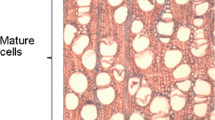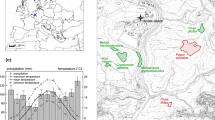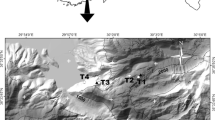Abstract
Monthly stem increment of 766 trees was assessed for 7 years in Kakamega Forest, Kenya and related to monthly climatic variables. Mean stem increment of all tree individuals correlated negatively with maximum temperature but not with mean and minimum temperatures. For the precipitation variables sum of precipitation and number of rainy days we found positive correlations. Stem increment of the trees in the early-, mid-, and late-successional groups correlated positively with the number of rainy days. For late-successional trees increment correlated negatively with mean and maximum temperature and positively with all other precipitation variables. For mid-successional trees we found a negative correlation with mean temperature. In addition, the stem increment of most species related positively to precipitation variables and negatively to mean and maximum temperature. In view of the expected increasing temperatures and fewer but heavier rain events, our results suggest that climate change will lead to a reduction in stem increment. The results appertaining to the successional groups imply that early and mid-successional species are better equipped to perform well under the expected future climatic conditions than the late-successional species. This could reduce the role of this East African forest as a carbon store. As the responses to climatic variables were highly group- and species-specific it is likely that climate change will result in a species composition shift, presumably in favour of drought-resistant and heat-tolerating species.




Similar content being viewed by others
References
Althof AJ (2005) Human impact on flora and vegetation of Kakamega forest, Kenya. Dissertation, University of Koblenz-Landau, Germany, pp 1–205
Baker TR, Burslem DFRP, Swaine MD (2003) Associations between tree increment, soil fertility and water availability at local and regional scales in Ghanaian tropical precipitation forest. J Trop Ecol 19:109–125. doi:10.1017/S0266467403003146
Bazzaz FA (1979) The physiological ecology of plant succession. Annu Rev Ecol Syst 10:351–371
Becker GS, Braun D, Gliniars R, Dalitz H (2012) Relations between wood variables and how they relate to tree size variables of tropical African tree species. Trees 26(4):1–28. doi:10.1007/s00468-012-0687-6
Boko MI, Niang A, Nyong C, Vogel A, Githeko M, Medany B, Osman-Elasha R, Tabo and P Yanda (2007): Africa. Climate Change 2007: impacts, adaptation and vulnerability. In: contribution of working group II to the fourth assessment report of the intergovernmental panel on climate change, ML Parry, of Canziani, JP Palutik of, PJ van der Linden and CE Hanson (eds), Cambridge University Press, Cambridge UK, pp 433–467
Brando PM, Nepstad DC, Davidson EA et al (2008) Drought effects on litterfall, wood production and belowground carbon cycling in an Amazon forest: results of a throughfall reduction experiment. Philos Trans R Soc Lond B Biol Sci 363:1839–1848. doi:10.1098/rstb.2007.0031
Braun D (2010) Wood density and carbon content of tropical tree species from two East African forests. Diploma thesis, University of Hohenheim, pp 1–123
Brncic TM, Willis KJ, Harris DJ et al (2009) Fire and climate change impacts on lowland forest composition in northern Congo during the last 2580 years from palaeoecological analyses of a seasonally flooded swamp. Holocene 19:79–89. doi:10.1177/0959683608098954
Bullock SH (1997) Effects of seasonal rainfall on radial increment in two tropical tree species. Int J Biometeorol 41:13–16. doi:10.1007/s004840050047
Cernusak LA, Winter K, Aranda J, Turner BL, Marshall JD (2007) Transpiration efficiency of a tropical pioneer tree (Ficus insipida) in relation to soil fertility. J Exp Bot 58(13):3549–3566
Clark DA (2004) Tropical forests and global warming: slowing it down or speeding it up? Front Ecol Environ 2:73. doi:10.2307/3868213
Clark DA (2007) Detecting tropical forests’ responses to global climatic and atmospheric change: current challenges and a way forward. Biotropica 39(1):4–19. doi:10.1111/j.1744-7429.2006.00227.x
Clark DA, Clark DB (1999) Assessing the increment of Tropical rain forest trees: issues for forest modeling and management. Ecol Appl 9:981–997
Clark DA, Piper SC, Keeling CD, Clark DB (2003) Tropical precipitation forest tree increment and atmospheric carbon dynamics linked to interannual temperature variation during 1984–2000. Proc Natl Acad Sci USA 100:5852–5857. doi:10.1073/pnas.0935903100
Clark DB, Clark DA, Oberbauer SF (2010) Annual wood production in a tropical precipitation forest in NE Costa Rica linked to climatic variation but not to increasing CO2. Global Change Biol 16:747–759. doi:10.1111/j.1365-2486.2009.02004.x
Cleveland CC, Townsend AR, Taylor P, Alvarez-Clare S, Bustamante MMC, Chuyong G, Dobrowski SZ et al (2011) Relationships among net primary productivity, nutrients and climate in tropical rain forest: a pan-tropical analysis. Ecol Lett 14(9):939–947. doi:10.1111/j.1461-0248.2011.01658.x
Corlett RT (2011) Impacts of warming on tropical lowland rainforests. Trends Ecol Evol 26:606–613. doi:10.1016/j.tree.2011.06.015
da Silva RP, dos Santos J, Tribuzy ES et al (2002) Diameter increment and increment patterns for individual tree growing in Central Amazon, Brazil. For Ecol Manage 166:295–301. doi:10.1016/S0378-1127(01)00678-8
Daubenmire R (1972) Phenology and other characteristics of tropical semi-deciduous forest in northwestern Costa Rica. J Ecol 60:147–180
Diffenbaugh NS, Scherer M (2011) Observational and model evidence of global emergence of permanent, unprecedented heat in the 20(th) and 21(st) centuries. Clim chang 107(3–4):615–624. doi:10.1007/s10584-011-0112-y
Doughty CE, Goulden ML (2008) Are tropical forests near a high temperature threshold? J Geophys Res 113:1–12. doi:10.1029/2007JG000632
Fashing PJ (2004) Mortality trends in the African cherry (Prunus africana) and the implications for colobus monkeys (Colobus guereza) in Kakamega Forest, Kenya. Biol Cons 120:449–459. doi:10.1016/j.biocon.2004.03.018
Feeley KJ, Davies SJ, Noor MNS et al (2007) Do current stem size distributions predict future population changes? An empirical test of intraspecific patterns in tropical trees at two spatial scales. J Trop Ecol 23:191. doi:10.1017/S0266467406003919
Fichtler E, Clark DA, Worbes M (2003) Age and long-term growth of trees in an old-growth tropical rain forest, based on analyses of tree rings and 14C1. Biotropica 35(3):306–317. doi:10.1111/j.1744-7429.2003.tb00585.x
Field CB, Behrenfeld MJ, Randerson JT, Falkowski P (1998) Primary production of the biosphere: integrating terrestrial and oceanic components. Science 281:237–240
Fischer E, Rembold K, Althof A, Obholzer J (2010) Annotated checklist of the vascular plants of Kakamega forest, Western Kenya. J East Afr Nat Hist 99:129–226
Glenday J (2006) Carbon storage and emissions offset potential in an East African tropical rainforest. For Ecol Manage 235:72–83. doi:10.1016/j.foreco.2006.08.014
Gliniars R (2011) Tree increment and tree regeneration in two East African precipitation forests as related to the abiotic environment after human disturbance. Dissertation University of Hohenheim, Germany, pp 1–198. http://opus.ub.uni-hohenheim.de/volltexte/2011/545/
Harrison L, Michaelsen J, Funk C, Husak G (2011) Effects of temperature changes on maize production in Mozambique. Clim Res 46(3):211–222. doi:10.3354/cr00979
Homeier J (2004) Baumdiversität, Waldstruktur und Wachstumsdynamik zweier tropischer Bergregenwälder in Ecuador und Costa Rica. Dissertation University of Bielefeld, Germany, pp 1–181
Hopkins B (1970) Vegetation of the Olokemeji forest reserve, Nigeria: VI. The plants on the forest site with special reference to their seasonal increment. J Ecol 58:765–793
Hüve K, Bichele I, Rasulov B, Niinemets ÜLO (2011) When it is too hot for photosynthesis: heat-induced instability of photosynthesis in relation to respiratory burst, cell permeability changes and H2O2 formation. Plant Cell Environ 34(1):113–126. doi:10.1111/j.1365-3040.2010.02229.x
Jama B, Ndufa JK, Buresh RJ, Shepherd KD (1998) Vertical distribution of roots and soil nitrate: tree species and phosphorus effects. Soil Sci Soc Am J 62:280–286. doi:10.2136/sssaj1998.03615995006200010036x
Keeland BD, Young PJ (2007) Construction and installation of dendrometer bands for periodic tree-growth measurement. http://www.nwrc.usgs.gov/Dendrometer/
Knapp AK, Beier C, Briske DD et al (2008) Consequences of more extreme precipitation regimes for terrestrial ecosystems. Bioscience 58:1–11
Laurance WF, Carolina Useche D, Shoo LP, Herzog SK, Kessler M, Escobar F, Brehm G et al (2011) Global warming, elevational ranges and the vulnerability of tropical biota. Biol Cons 144:548–557
Lewis SL (2006) Tropical forests and the changing earth system. Philos Trans R Soc Lond B Biol Sci 361:195–210. doi:10.1098/rstb.2005.1711
Lieberman D (1982) Seasonality and phenology in a dry tropical forest in Ghana. J Ecol 70:791–806
Lung T (2004) Landbedeckungsänderungen im Gebiet “Kakamega forest und assoziierte Waldgebiete” (Westkenia): Multispektrale Klassifikation von Landsat-Satellitenbilddaten und Auswertung mittels Methoden im Raster-gis. Fachhochschule Karlsruhe—Hochschule für Technik, Fachbereich Geoinformationswesen, pp 1–114
Malhi Y, Grace J (2000) Tropical forests and atmospheric carbon dioxide. J Geophys Res 15(8):332–337. doi:10.1029/98JD02647
Malhi Y, Wright J (2004) Spatial patterns and recent trends in the climate of tropical rainforest regions. Philos Trans R Soc Lond B Biol Sci 359:311–329. doi:10.1098/rstb.2003.1433
Malhi Y, Wood D, Baker TR, Wright J, Phillips OL, Cochrane T, Meir P et al (2006) The regional variation of aboveground live biomass in old-growth Amazonian forests. Glob Change Biol 12(7):1107–1138. doi:10.1111/j.1365-2486.2006.01120.x
Mitchell N, Schaab G (2008) Developing a disturbance index for five East African forests using GIS to analyse historical forest use as an important driver of current land use/cover. Afr J Ecol pp 1–13
Murphy PG, Lugo AE (1986) Ecology of tropical dry forest. Annu Rev Ecol Syst 17:67–88. doi:10.1146/annurev.es.17.110186.000435
Musila WM (2007) Multi-scale Analysis of spatial heterogeneity of Kakamega tropical forest soils: role of disturbance, succession, soil depth, trees and NIRS. Dissertation, University of Hohenheim pp 183
Nath CD, Dattaraja HS, Suresh HS et al (2006) Patterns of tree increment in relation to environmental variability in the tropical dry deciduous forest at Mudumalai, southern India. J Biosci 31:651–669
Nepstad DC, Moutinho P, Dias-Filho MB, Davidson E, Cardinot G, Markewitz D, Figueiredo R et al (2002) The effects of partial throughfall exclusion on canopy processes, aboveground production, and biogeochemistry of an Amazon forest. J Geophys Res 107(D20):8085. doi:10.1029/2001JD000360
Nogueira A, Martinez CA, Ferreira LL, Prado CHBA (2004) Photosynthesis and water use efficiency in twenty tropical tree species of differing succession status in a Brazilian reforestation. Photosynthetica 42(3):351–356
Okali DUU, Ola-Adams BA (1987) Tree population changes in treated precipitation forest at Omo Forest Reserve, south-western Nigeria. J Trop Ecol 3:291–313
Reed SC, Wood TE, Cavaleri MA (2012) Tropical forests in a warming world. New Phytol 193(1):27–29. doi:10.1111/j.1469-8137.2011.03985.x
Rollenbeck R, Bendix J, Fabian P, Boy J, Dalitz H, Emck P, Oesker M, Wilcke W (2007) Comparison of different techniques for the measurement of precipitation in tropical montane rain forest regions. J Atmos Oceanic Technol 24:156–168. doi:10.1175/JTECH1970.1
Sheil D (1997) Long term increment and rainfall in a Ugandan moist forest: seasonal rhythms and flexing stems. Commonw For Rev 76:121–127
Swaine MD, Lieberman D, Hall JB (1990) Structure and dynamics of a tropical dry forest in Ghana. Vegetatio 88:31–51
Toledo M, Poorter L, Peña-Claros M et al (2011) Climate is a stronger driver of tree and forest increment rates than soil and disturbance. J Ecol 99:254–264. doi:10.1111/j.1365-2745.2010.01741.x
Toledo M, Peña-Claros M, Bongers F et al (2012) Distribution patterns of tropical woody species in response to climatic and edaphic gradients. J Ecol 100:253–263. doi:10.1111/j.1365-2745.2011.01890.x
Vieira S, de Camargo PB, Selhorst D et al (2004) Forest structure and carbon dynamics in Amazonian tropical precipitation forests. Oecologia 140:468–479. doi:10.1007/s00442-004-1598-z
Worbes M (1995) How to measure increment dynamics in tropical trees. IAWA J 16:337–351
Worbes M (1999) Annual increment rings, rainfall-dependent increment and long-term increment patterns of tropical trees from the Caparo Forest Reserve in Venezuela. J Ecol 87:391–403. doi:10.1046/j.1365-2745.1999.00361.x
Wright SJ, Muller-Landau HC, Schipper J (2009) The future of tropical species on a warmer planet. Conserv Biol 23:1418–1426. doi:10.1111/j.1523-1739.2009.01337.x
Acknowledgments
We thank the field assistants Jared Sajita, Lenah Barasa and Patrick Kilei for their valuable assistance in the collection of data. Special thanks go to Jörg Waltemathe for helping to create a relational database to handle the large amount of data. We thank Pamela Gliniars for correcting the English. We thank Winfred Musila, Mathias Oesker, Henning Todt and Dana Uster for giving valuable advice and partly providing complementary data in the course of the study. Lastly, we thank the BIOTA (Biodiversity Monitoring Transect Analysis in Africa) project (http://www.biota-africa.org), funded by the German Federal Ministry of Education and Research (BMBF), subproject BIOTA-East E03 “Regeneration of tropical trees” FKZ: 01LC0625F1.
Author information
Authors and Affiliations
Corresponding author
Additional information
Communicated by A. Braeuning.
Rights and permissions
About this article
Cite this article
Gliniars, R., Becker, G.S., Braun, D. et al. Monthly stem increment in relation to climatic variables during 7 years in an East African rainforest. Trees 27, 1129–1138 (2013). https://doi.org/10.1007/s00468-013-0863-3
Received:
Revised:
Accepted:
Published:
Issue Date:
DOI: https://doi.org/10.1007/s00468-013-0863-3




